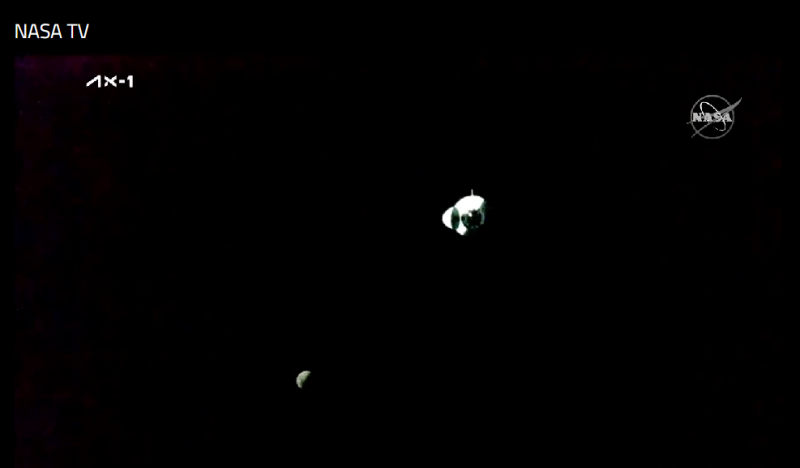
Ax-1 arrives at the space station
The first paying astronauts reached the International Space Station on Saturday morning, April 9. The crew of Ax-1 includes three playing customers – at $55 million each – plus a fourth experienced astronaut. Ax-1 successfully launched Friday morning from Kennedy Space Center. As the Dragon capsule neared the International Space Station, NASA TV aired the event live, and a first-quarter moon appeared in the background.
The Houston-based startup Axiom Space organized the private mission. The launch of Axiom-1, or Ax-1 took place at 15:17 UTC (11:17 a.m. EDT) on Friday. The mission went up from historic Launch Complex 39-A at Florida’s Kennedy Space Center.

Meet the crew
In the Ax-1 mission, the four astronauts riding into low-Earth orbit are:
– Mission commander Michael López-Alegría. Lopez-Alegria is an astronaut and test pilot. He went up on the space shuttle three times, and he’s been to the International Space Station mission once before. He is also Axiom’s vice president of business development.
– Pilot Larry Connor, a real estate and technology entrepreneur and aerobatics aviator from Ohio.
– Mission Specialist Eytan Stibbe, an Israeli a former fighter pilot and businessman.
– Mission Specialist Mark Pathy, a Canadian businessman and philanthropist.
Reuters reported on April 4 that Friday’s launch:
… is being hailed by the company, NASA and other industry players as a turning point in the latest expansion of commercial space ventures, collectively referred to by insiders as the low-Earth orbit economy, or LEO economy for short.

What will the Ax-1 crew do aboard ISS?
The Ax-1 mission shares some qualities with recent suborbital flights by Jeff Bezos, Richard Branson and Elon Musk – in what’s been called the billionaire space race. But it’s not the same, according to the crew of Ax-1. As reported in Reuters, Lopez-Alegria said during a recent news briefing:
We are not space tourists.
Lopez-Alegria said the Axiom team has undergone extensive astronaut training with both NASA and SpaceX and will be performing meaningful biomedical research during their eight-day stay at the ISS.

Specifically, while in space, the Ax-1 crew will conduct experimental research for a variety of partners back on Earth, according to a statement by Christian Maender, director of In-space Manufacturing and Research for Axiom:
As the first step on a path to building a diverse, thriving economy in low-Earth orbit, Axiom has partnered with leaders in academia and industry. [The goal is] to bring new users and new investigations in research to the space station. The collection of biological and technological tests during the Ax-1 mission represent a breadth of research that will inform everything from human health considerations, to novel infrastructure and design for our future homes away from Earth …
1st private space station?
Eventually, Axiom wants to build the first private crewed space station in low-Earth orbit. They’re calling it the Axiom Station. And the company has said the visit to the existing International Space Station is a step toward that.
NASA’s plan for commercial traffic
The Ax-1 mission represents the first paying customers taking advantage of NASA’s plan to open the ISS to crews of commercial astronauts. NASA announced that plan in June 2019, with the stated goal of building a viable space-based economy:
NASA will continue research and testing in low-Earth orbit to inform its lunar exploration plans, while also working with the private sector to test technologies, train astronauts and strengthen the burgeoning space economy. Providing expanded opportunities at the International Space Station to manufacture, market and promote commercial products and services will help catalyze and expand space exploration markets for many businesses.
Ultimately, NASA said that allowing private companies to rent time for their crews at the ISS will benefit the entire space industry by reducing the cost of getting into space. NASA stated:
The agency’s ultimate goal in low-Earth orbit is to partner with industry to achieve a strong ecosystem in which NASA is one of many customers purchasing services and capabilities at lower cost.
SpaceX and space tourism
Meanwhile, SpaceX, which is launching the Ax-1 mission, is no stranger to the commercial space tourism and exploration business. In September of last year, the company launched Inspiration4, the first all-civilian spaceflight. This was a four-person mission led and funded by commercial astronaut Jared Isaacman, billionaire CEO of private air force provider Draken International and payment processor Shift4 Payments. That mission served in part as a fundraiser for St. Jude’s Children’s Research Hospital.
Isaacman has purchased an additional series of three flights, the first of which, Polaris Dawn, could launch this November. The mission parameters include taking humans farther from Earth than they have been since the end of the Apollo missions to the moon. They will also attempt the first commercial space walk, according to the mission website:
At approximately 500 kilometers above the Earth, the crew will attempt the first-ever commercial extravehicular activity (EVA) with SpaceX-designed extravehicular activity (EVA) spacesuits, upgraded from the current intravehicular (IVA) suit. Building a base on the moon and a city on Mars will require thousands of spacesuits; the development of this suit and the execution of the EVA will be important steps toward a scalable design for spacesuits on future long-duration missions.
SpaceX’s very first foray into space tourism, however, came back in 2018, when the company announced it had sold a ride around the moon to Japanese fashion billionaire Yusaku Maezawa.
According to his dearMoon.earth website, Maezawa’s trip could fly as early as 2023 with an eight-person crew of “talented individuals” selected from the public at large.
The trip will last one week.
Bottom line: Ax-1 with the 1st all-private astronaut team ever flown to the International Space Station arrived at the ISS on April 9. The astronauts will conduct research during their stay.











